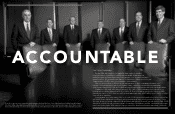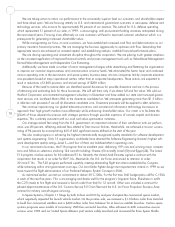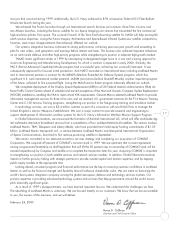Lockheed Martin 1999 Annual Report Download - page 14
Download and view the complete annual report
Please find page 14 of the 1999 Lockheed Martin annual report below. You can navigate through the pages in the report by either clicking on the pages listed below, or by using the keyword search tool below to find specific information within the annual report.
21
MANAGEMENT’S DISCUSSION AND ANALYSIS OF FINANCIAL CONDITION
AND RESULTS OF OPERATIONS
December 31, 1999
Lockheed Martin Corporation (Lockheed Martin or the
Corporation) is engaged in the conception, research,
design, development, manufacture, integration and oper-
ation of advanced technology systems, products and serv-
ices. The Corporation serves customers in both domestic
and international defense and commercial markets, with its
principal customers being agencies of the U.S. Government.
The following discussion should be read in conjunction with
the audited consolidated financial statements included herein.
Strategic and Organizational Review
In September 1999, Lockheed Martin announced the results
to date of its strategic and organizational review that began
in June 1999. As a result of this review, the Corporation
has implemented a new organizational structure (as more
fully described in Note 17 of the Notes to Consolidated
Financial Statements, “Information on Industry Segments and
Major Customers”), and announced plans to evaluate the
repositioning of certain businesses to maximize their value
and growth potential and the divestiture of certain non-core
business units.
The Corporation is continuing to evaluate alternatives
relative to maximizing the value of two business units that
serve the commercial information technology markets,
including Lockheed Martin’s internal information technology
needs. These units have been identified by management
as having high growth potential, but are distinct from the
Corporation’s core business segments. The Corporation
may seek to maximize the value of these business units
through strategic partnerships or joint ventures, or by
accessing public equity markets, although the outcome
of those efforts cannot be predicted. Management has
decided to evaluate for divestiture, subject to appropriate
valuation, negotiation and approval, a third business unit
originally identified for evaluation relative to maximizing its
value. This business unit serves state and local government
services markets.
The Corporation is also continuing its evaluation of
the divestiture, subject to appropriate valuation, negotiation
and approval, of certain business units in the aerospace
electronics, control systems and environmental management
lines of business. On a combined basis, net sales in 1999
related to the business units being evaluated for divestiture,
including the business unit in the state and local government
services market described above, totaled $1.9 billion. The
divestiture of one business unit in the environmental manage-
ment line of business was consummated in December 1999,
the impact of which was not material to the Corporation’s
net earnings. Relative to all other business units identified for
potential divestiture, based on preliminary data, and assum-
ing that the potential divestiture transactions are approved
by the Board and ultimately consummated in the future,
management estimates that the potential one-time effects,
if combined, could result in a net loss on disposition of
approximately $850 million, primarily non-cash. How-
ever, the potential proceeds from these transactions, if
consummated, could also generate in excess of $1.5 billion
in cash, after transaction costs and associated tax pay-
ments, that will be used to repay debt. Financial effects
that may result, if any, would be recorded when the trans-
actions are consummated or when losses can be estimated.
Management cannot predict the timing of the potential
divestitures, the amount of proceeds that may ultimately
be realized or whether any or all of the potential transac-
tions will take place.
In a further development related to the strategic and
organizational review, the Corporation announced in
January 2000 its plans to streamline the Aeronautical
Systems and Space Systems segments. These plans provide
for the consolidation of multiple business units into one
focused company in each segment, and the integration
of certain operational and administrative activities within
each segment. Management expects these actions to result
in future cost savings for the Corporation.
On an ongoing basis, the Corporation will continue to
explore the sale of various investment holdings and surplus
real estate, review its businesses to identify ways to improve
organizational effectiveness and performance, and clarify
and focus on its core business strategy.
Transaction Agreement with COMSAT Corporation
In September 1998, the Corporation and COMSAT
Corporation (COMSAT) announced that they had entered
into an agreement (the Merger Agreement) to combine
the companies in a two-phase transaction (the Merger).
In connection with the first phase of this transaction, the
Corporation completed a cash tender offer (the Tender
Offer) on September 18, 1999, after satisfaction of all
MANAGEMENT’S DISCUSSION AND ANALYSIS OF FINANCIAL CONDITION
AND RESULTS OF OPERATIONS
December 31, 1999
























